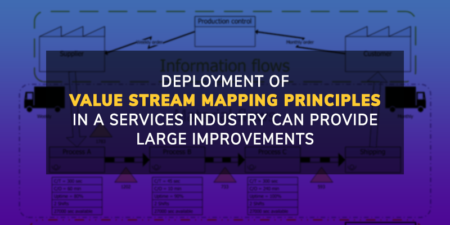Deployment of Value stream mapping principles in a services industry can provide large improvements
- Home
- Thought leadership – 3
Deployment of Value stream mapping principles in a services industry can provide large improvements
The most important aspect that a company needs to focus on in order to ensure profitability for itself is to control the cost of production. The major contributors to the cost aspect of production tend to be Manpower cost, Material cost, Machinery cost and Facility cost. The aforementioned costs need to be optimised to ensure maximum profitability from the product.
Productivity programs are commonly deployed for the production side of the product based companies and not much emphasis is paid to the service side that eventually becomes the face of the product in front of the customer.
Often, the requirement of the manpower in a production/service setup is taken to be equivalent to the sales generated and not optimised keeping into account the repeatability of the job being done.
For example, if the firm is employing x manpower for Rs. 100 million in sales, a common misnomer is that for executing sales of Rs. 200 million, 2x manpower would be required. There is a famous economic concept called ‘Developing learning economies’ where over time a person becomes more efficient at the job he repeatedly executing.
For example: If a service engineer can peel a wire in 10 minutes on his first day at work, after doing the activity multiple times, the time needed by him to peel the wire will come down to 5 minutes.
Keeping that concept in mind it would be fallacious to assume that to do a higher number of sales; you need to proportionately increase the manpower required.
A process known as Value Stream Mapping is used to map the current engagement level of the service engineer in the field and design a future and more efficient process based on the on field observations done.
The process entails a detailed day in life study where the service engineer is shadowed by a consultant who allocates the time spent by the engineer on the field as Value added and Non Value added time. This exercise is known as a Lost Time Assessment and gives an insight into the possible capacity enhancements for the company.
The observations also help the consultant to propose Activity Standards for the various activities executed by the Service engineer for effective measurement of the time spent by the service engineer.
The data collected enables the consultant to create an Area Workload Assessment document which lists the Value added and Non value added time spent by the engineer along with the productive time spent and based on that calculates the amount of manpower required to execute the quantum of work available. The tool establishes a relationship between the Revenue earned by a company in a particular year and the work executed in that year and hence can be used for future manpower projections by the company.
The tool also enables the consultant to give recommendations on how to reduce the Non Value Added time or ‘Lost time’ and what will be the estimated saving from the action.
It is handed over to the Manpower Planning Cell established at the organisation which then effectively monitors the manpower requirements in the organisation in line with the organisational revenue goal leading to large savings for the company.
Enquire Now
Popular searches
- Business Consulting Services
- Business Consultancy in Mumbai
- Business Consultancy in Bangalore
- Business Consultant in Chennai
- Business Consultants in Hyderabad
- Business Growth Consultant
- Business Strategy Consultant
- Compliance and Risk Management
- HR Services in Mumbai
- HR Outsourcing Company in India
- Legal Compliance
- Payroll Management Services
- Salary Benchmarking
- Statutory Compliance in HR




